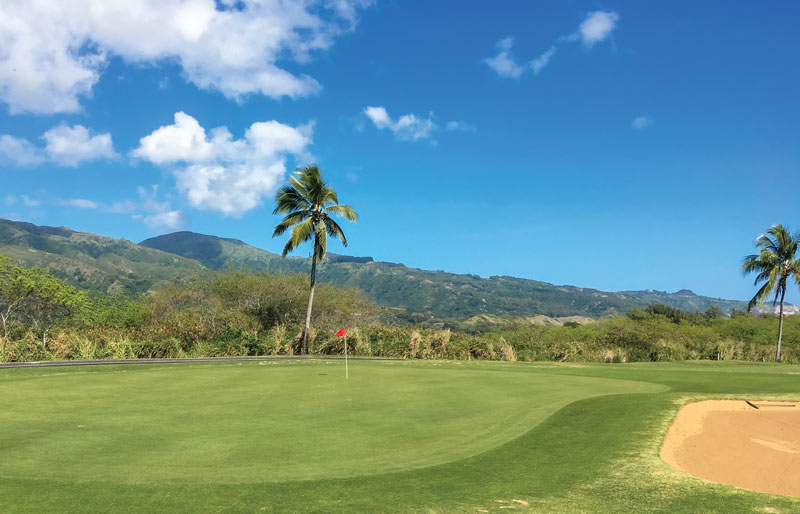
The renovation of Waiehu Golf Course in Hawaii — performed in-house and under a tight budget — was split into halves. The back nine greens (including No. 14, pictured) were part of the first half of the renovation, completed in May 2018. Photo courtesy of Todd Allen
At Waiehu Golf Course on Maui, GCSAA Class A superintendent Todd Allen is halfway through a renovation of all 18 greens, three of which border the Pacific Ocean. Deep blue water, white sand, palm trees swaying in the trade winds breeze ... yeah, it’s everything Hawaiian golf should be.
“It’s a special place,” Allen says. But — and there’s always a “but” — unlike many of the famous resort courses in the islands, where generous maintenance budgets are funded by tourist dollars, Waiehu Golf Course is owned by Maui County. It’s a muni — a municipal golf course — that was created in 1928 for the people of Maui County to enjoy affordable golf. Green fees for Maui residents are $15 during the week, $22 on the weekend.
So here, in one of the most breathtaking spots on the planet, Allen operates within the county’s allocated budget, and he has used his expertise, crew and creativity to renovate a piece of paradise completely in-house.
Beyond the budget, another challenge Allen faced was a grow-in timeline of just 12 weeks with a small crew. “We needed to keep the course open, provide affordable recreation and generate revenue during the entire renovation project,” he says.
Waiehu Golf Course supports upward of 65,000 rounds of golf per year, so the course decided to split the project into two parts. The back nine greens, collars and approaches were renovated in May 2018, with the front-nine renovation of another 2 acres getting underway in May of this year.
Readying for a renovation
By the time Allen took the helm at Waiehu four years ago, the Tifgreen 328 bermudagrass greens were thin and infested with goosegrass. Because of the course’s oceanfront location, salt is always an issue, and heavy, regular play takes its toll.
“Our winters are cold and wet, and you get a lot of bermudagrass decline and Pythium root rot. Because of heavy play, we had extensive compaction. The goosegrass comes in, and the seeds are prolific. We had decades upon decades of goosegrass seed on the course,” says Allen, a 13-year GCSAA member.
To begin the project, Allen sprayed out the renovation areas with herbicides, and then the crew used several methods to remove the dead grass surface, including verticutting, scalping, sod cutting and fraze mowing. The goal was to remove all remaining plant material and debris and get back down to the original dune sand.
“We didn’t want to lose any of our contouring. We used a walk-behind aerifier and a drag mat on top of the greens and a Shockwave at 12 inches deep in two different directions on the approaches,” Allen says. “A recycling dresser was used on the approaches to soften and recycle the existing dune sand, creating a really nice bed to plant the sprigs into. It took us a week and a half of eight-hour days with a crew of 14 guys working together.
“We removed old organic material, incorporated new silica sand, and softened up the surface to be able to have sprigs cut into it. We still had to maintain the rest of the golf course as best as we could. Doing it in-house was going to save the county a lot of money, while remaining open for play would help minimize our losses in revenue.”
Goodbye, goosegrass
Allen knew goosegrass would continue to be a fact of life at Waiehu, but he had a plan to deal with that, too. His choice of a salt-tolerant turfgrass variety would help.
After extensive research, Allen concluded that converting the greens to a variety of seashore paspalum turfgrass would be the wisest course of action. “I wasn’t aware at the time, but the USGA has been recommending that this golf course be switched to paspalum for the last 20 years,” Allen says.
In his quest for the right cultivar, Allen consulted with Paul Raymer, Ph.D., professor and turfgrass breeder at the University of Georgia in Griffin, Ga. Raymer spearheads the renowned paspalum breeding program that, over the years, has produced some of today’s standard varieties of paspalum, including SeaIsle 1, SeaIsle 2000, SeaIsle Supreme and, most recently, SeaStar seashore paspalum.
Raymer thinks paspalum was the right choice for the Waiehu project. “Paspalum loves Hawaii,” Raymer says. “Where salt is an issue, it’s a no-brainer. It provides a much greater flexibility for the management of salt-affected sites.”
Allen looked for sources of paspalum in Hawaii and found Hawaiian Turfgrass on the island of Oahu, the state’s exclusive licensed grower of SeaStar seashore paspalum.
“We did the practice putting green two summers ago to help demonstrate to the county council and our golfers that this renovation would be a worthwhile investment and a huge improvement to Waiehu,” Allen says.
The test green also gave Allen the opportunity to experiment with using salt to combat his biggest issue: the relentless goosegrass. He had always read about using salt for weed control in seashore paspalum, but Allen says he was still surprised it was able to get rid of the weeds so easily. “The grass didn’t change color,” he says. “The salt acted like a growth regulator. When we were mowing, we weren’t taking up as many clippings. The grass was still healthy, dark green and playable. It’s not a real new tactic to use salt, but it’s a technique we used with success.”
In praise of paspalum
In Allen’s 23-year tenure as a golf course superintendent, he says he has never seen anything root as quickly as SeaStar seashore paspalum. When Allen’s crew — along with 12 members of the parks and rec beautifications crew — hand-planted the SeaStar sprigs on the back nine greens, collars and approaches of Waiehu Golf Course in the first week of June 2018, “within two to three days, we already had some phenomenal roots coming down,” he says.
“Usually, on all of the greens that I’ve renovated and sprigged, you’ll have a week where the sprigs look almost dead, then a week and a half later, with good water supply keeping the sprigs wet, you’ll see some movement,” Allen says. “I haven’t seen anything root that rapidly or a grow-in as phenomenal as what I saw with SeaStar.”
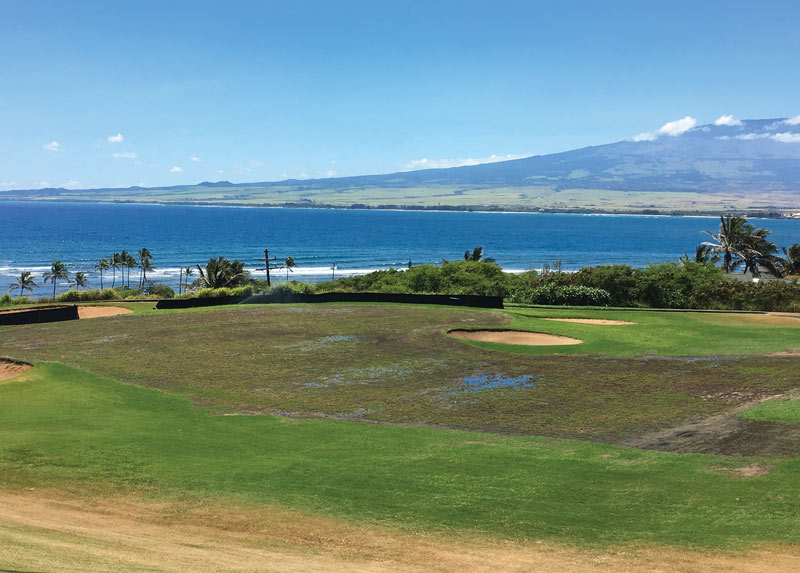

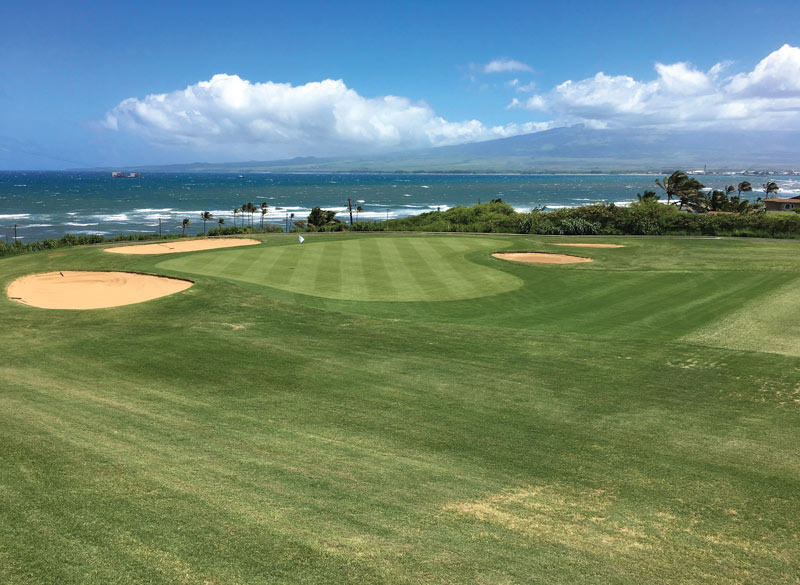
Three stages of Waiehu Golf Course’s No. 15 green in 2018: newly sprigged with seashore paspalum in June (top); after a heavy salt topdressing in August (middle), which is an environmentally friendly way to eradicate weeds — in this case, goosegrass; and open for play in September (bottom). Photos courtesy of Todd Allen
Allen credits the fast grow-in to several factors. One is simply the nature of the variety. In the National Turfgrass Evaluation Program trials and in University of Georgia tests, SeaStar had excellent turf quality, density, salt tolerance, leaf texture and cool weather tolerance as well as a lower propensity for scalping. In other words, it has vigor.
The planting rate was also a factor. The sprigs were planted at a heavy rate to meet the 12-week playability requirement. Sprigs were planted at 2 bushels of sprigs per 100 square feet. One bushel per 100 square feet is standard.
“We used a pre-plant organic fertilizer, humic acids and gypsum,” Allen says. “I imagine that had a lot to play into it as well. There was plenty of food there for the roots. Once they started tacking down, they just exploded.”
Well-tended, well-traveled sprigs
Even the way the sprigs were grown on the farm at Hawaiian Turfgrass had an impact. While most sod producers on the mainland grow sod directly in their farm’s native soil, at the Hawaiian Turfgrass farm in Mililani on Oahu (a region not far from Honolulu known for its red dirt), the grass never touches the soil.
Instead, explains Sean Fong, president of Hawaiian Turfgrass, the grass is grown on plastic sheeting that covers the soil. The sprigs are spread onto the plastic, then covered with a layer of high-quality, green waste compost. The sprigs are watered four to five times a day and kept moist. Depending on the season, it takes three to five months to grow into sod.
When the sod is ready, it is separated from the plastic and harvested in rolls. The rolls are washed and banged together to remove most of the compost growing medium, then shredded into sprigs.
“As the end product, when we sell the sod or sprigs, the customer gets the entire plant. They get the plant, the root, the rhizome, the stolon,” Fong says. “The plant is less stressed, and it is a higher-quality product because we are not cutting the sod or grass roots from the ground.”
In essence, when the sprigs hit the soil at their final destination, they are looking for a soil medium and are ready to take root.
To ship from Oahu to Maui, sprigs are saturated with water and loaded into sacks. The sacks are stacked onto pallets and trucked to the port in Honolulu, about 30 minutes away. The pallets are loaded into a refrigerated container and put on a barge. The barge sails the same day and arrives in Maui the next morning. Allen and his crew would pick up the sprigs and plant them the same day.
The barge sails three to four times each week, so timing harvest with planting was critical. Between harvest on Oahu and planting on the golf course, the sprigs were no more than two to four days out from compost to final soil. Hawaiian Turfgrass shipped 1,800 bushels to Waiehu throughout May and June of 2018 using this method, and repeated the process in May and June of this year to plant the front nine.
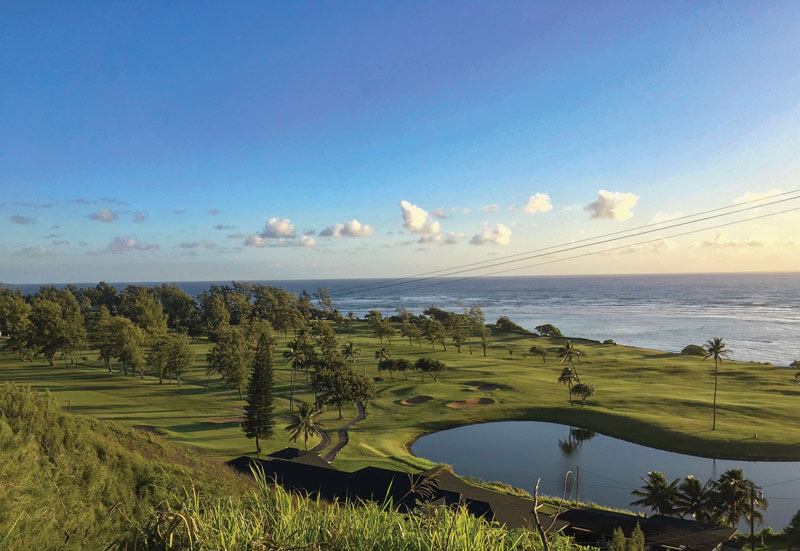
Municipal magic: Waiehu Golf Course boasts several oceanfront holes, offering patrons a round with a view. Photo courtesy of Todd Allen
Once on site at Waiehu, the sprigs were planted by hand. A homemade device with 10 discs attached was used to press them down into the soft soil “so that the grass has a soil contact to help them start rooting, to give the roots a place to go and to hold them into place from our windy conditions,” Allen says. “We did three greens, collars and approaches a day. We were done with the back nine in a week’s time. After that, we turned the water on. We used Maui Eko composted lawn topdressing to retain moisture and give us the beneficial nutrients and microorganisms we were looking for.”
Following planting, even though the sprigs were clean and free of weeds, Allen knew the site still had goosegrass seeds. After the SeaStar sprigs had established roots to 4 to 5 inches, “We made two applications of salt (sodium chloride) to the grass itself,” Allen says. “It wiped out all of the goosegrass weeds that were growing. It’s an environmentally friendly way to eradicate weeds. That was one of the things we were looking for — environmental sustainability.”
SeaStar was derived from a single seed at the University of Georgia, then vegetatively cloned. Every stolon and sprig of SeaStar is genetically identical to the next. Breeding the grass in this way creates a uniform, genetically pure stand of grass, which provides the optimal scenario for a putting surface.
“The thing with the paspalums ... we don’t see mutations arise,” Raymer says. And as for playability, the grass tends to have an upright nature. Adds Raymer, “With paspalums as a greens grass, we don’t see a grain.”
Fine-tuning fertilization
Raymer says that superintendents — especially those who are switching from bermudagrass — should be aware that seashore paspalum requires lower levels of nitrogen.
“Most paspalum superintendents on greens can take their N apps down dramatically, maybe 50% to 70% of what they do on bermuda,” Raymer says. “We recommend they use N to manage growth, back off to reduce the growth enough for repair, but not so much that it would dramatically slow putting speed.”
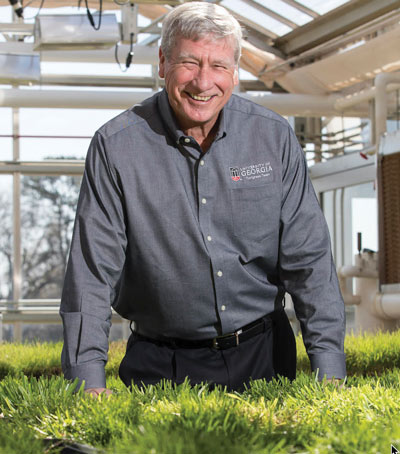
Right: Paul Raymer, Ph.D., professor and turfgrass breeder at the University of Georgia in Griffin, Ga., spearheads the paspalum breeding program. Photo courtesy of Paul Raymer
Allen agrees that paspalum uses less fertilizer. “A lot less,” he says. “I’ve realized the hard way that even though several have told me and I’ve read it, paspalum doesn’t require N that much. I’ve learned you barely need 2 pounds a year of N. Barely. It’s just some of your nutrients that are needed, mostly magnesium, calcium, manganese, potassium. And use other things in your arsenal, like wetting agents, plant protectants and nanosilica applications. I’ve seen a reduction in water, but how much I won’t know until all the greens are done.”
Allen adds, “It’s a little more time-intensive if you’re trying to maintain it mowed low and achieve a good ball roll. We do a lot more light topdressings, brushing and grooming, rolling. We try to incorporate rolling into our practices three times a week.
“The paspalum looks unbelievable and has a beautiful dark green color throughout the year. SeaStar has a definite ‘wow’ factor and draws your attention,” Allen says. “This is the right grass in the right location.”
To other superintendents considering a conversion to paspalum, Allen says: “If the conditions are like the location that I’m at, where I have a lot of salt air, a lot of sea spray, it’s definitely an extremely nice-quality grass. It’s almost better than I could have imagined.
“It’s one thing to do the research and talk about it. It’s another thing to accomplish all of the things you set out for yourself and your course and crew. Through our crew’s hard work and dedication to the county of Maui, we did an outstanding job of getting all the work done successfully and on time.”
Allen adds, “For a municipal golf course, for the people of the county of Maui, to give them a putting quality that’s better than they’ve seen before is an awesome achievement.”
Stacie Zinn Roberts is the president of What’s Your Avocado?, a writing and marketing firm based in Mount Vernon, Wash., and a frequent GCM contributor.